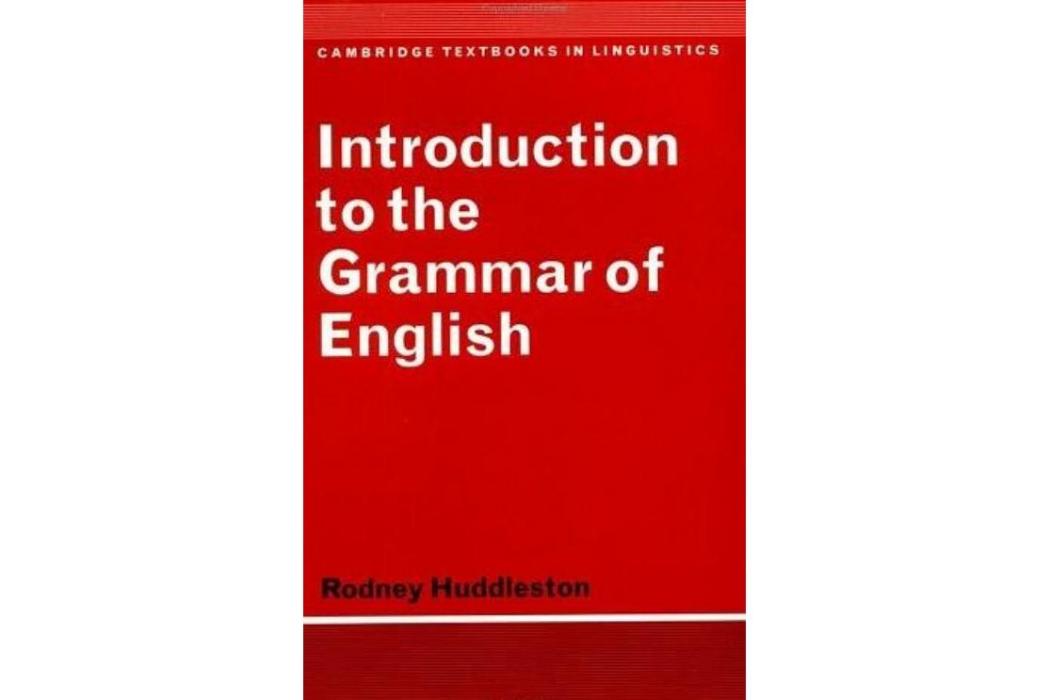《Introduction to the Grammar of English》是1984年Cambridge University Press出版的圖書,作者是Rodney Huddleston。
基本介紹
- 中文名:Introduction to the Grammar of English
- 作者:Rodney Huddleston
- 出版社:Cambridge University Press
- ISBN:9780521297042

《Introduction to the Grammar of English》是1984年Cambridge University Press出版的圖書,作者是Rodney Huddleston。
Composed for the Conveniency of Children Under Seven Years of Age.《An Easy Introduction to the English Grammar. Composed for the Conveniency of Children Under Seven Years of Age.》是一本圖書,作者是Joel, Thomas ...
《An Introductory English Grammar》是1999年Wadsworth Publishing出版的圖書,作者是Norman C. Stageberg、 Dallin D. Oaks。內容簡介 For the first time in more than fifteen years AN INTRODUCTION TO ENGLISH GRAMMAR is available ...
Fully updated and revised, this fourth edition of Halliday's Introduction to Functional Grammar explains the principles of systemic functional grammar, enabling you to understand and apply them in any context. Halliday's ...
4.1 The language of Old English poetry 4.2 OE prose 4.3 OE grammar 4.4 Latin loan-words in OE 4.5 ON loan-words in OE 4.6 Early French loan-words 5 FROM OLD ENGLISH TO MIDDLE ENGLISH 5.1 The evidence ...
Lecture 1 General Introduction on English Grammar and Grammar Learning Section 1 Two Different Approaches to Grammar Rules Section 2 Two Parts of English Grammar: Morphology and Syntax Section 3 The Central Topic of Morphology...
of language teaching methods. and a new model of good leaching practice-the 'ESA'model an essential introduction to grammar teaching sequences for grammar, vocabulary, and the individual language skills ideas on the ...
model of good leaching practice-the 'ESA'model an essential introduction to grammar teaching sequences for grammar, vocabulary, and the individual language skills ideas on the exploitation of textbooks and the planning of ...
1 Introduction:a corpus-based approach to English grammar SECTION B Basic grammar:description and distribution 2 Word and phrase grammar 3 Clause grammar SECTION C Key word classes and their phrases 4 Nouns,pronouns,and th...
other language, English eonsists of speech sound, grammatical structure and vocabulary. To learn English well, the very essential is to enlarge his/her vocabulary. English linguist Wilskin (1972) said, "Without grammar, ...
Introduction 0.1 Purpose and approaches 0.2 Hierarchical structure of English grammar Chapter One Composition of NP and VP 1.1 Two formulae 1.2 Composition of NP 1.3 Composition of VP Chapter Two NP: The Determiner ...
I. Introduction 1. What is lexicology?2. The five sub-branches of lexicology 3. The relations of lexicology to other branchesof linguistics 3.1 Its relation to general linguistics 3.2 Its relation to grammar 3.3 Its...
4 OLD ENGLISH (11)4.1 The language of Old English poetry 4.2 OE prose 4.3 OE grammar 4.4 Latin loan-words in OE 4.5 ON loan-words in OE 4.6 Early French loan-words 5 FROM OLD ENGLISH TO MIDDLE ENGLISH...
Exercises for the Chapter 106 Chapter 5 Language in T & L—A Functional Perspective to Language Teaching and Learning 107 5.1. A Brief Review of Major Language Teaching Methodologies 107 5.1.1. Grammar translation ...
Introduction Overview Basic Forms On terminology On being ungrammatical On good English Basic meanings 'I am more interesting in English Grammar'Why can I say 'I shot the sheriff', but not *'I smiled the sheriff'?Lin...
Introduction Overview Basic Forms On terminology On being ungrammatical On good English Basic meanings 'I am more interesting in English Grammar'Why can I say 'I shot the sheriff', but not *'...
UNIT 1 Introduction PART 1 Characteristics of English for Science and Technology PART 2 Grammar UNIT 2 Basic Reading and Writing Training PART 1 Text Reading PART 2 Grammar: the Usage of Articles PART 3 Key ...
literature. Although intended principally as a coursebookfor students of syntax or English grammar. Transformational Grammar will be invaluable to any reader who needs a straightforward and comprehensive introduction to the latest...
